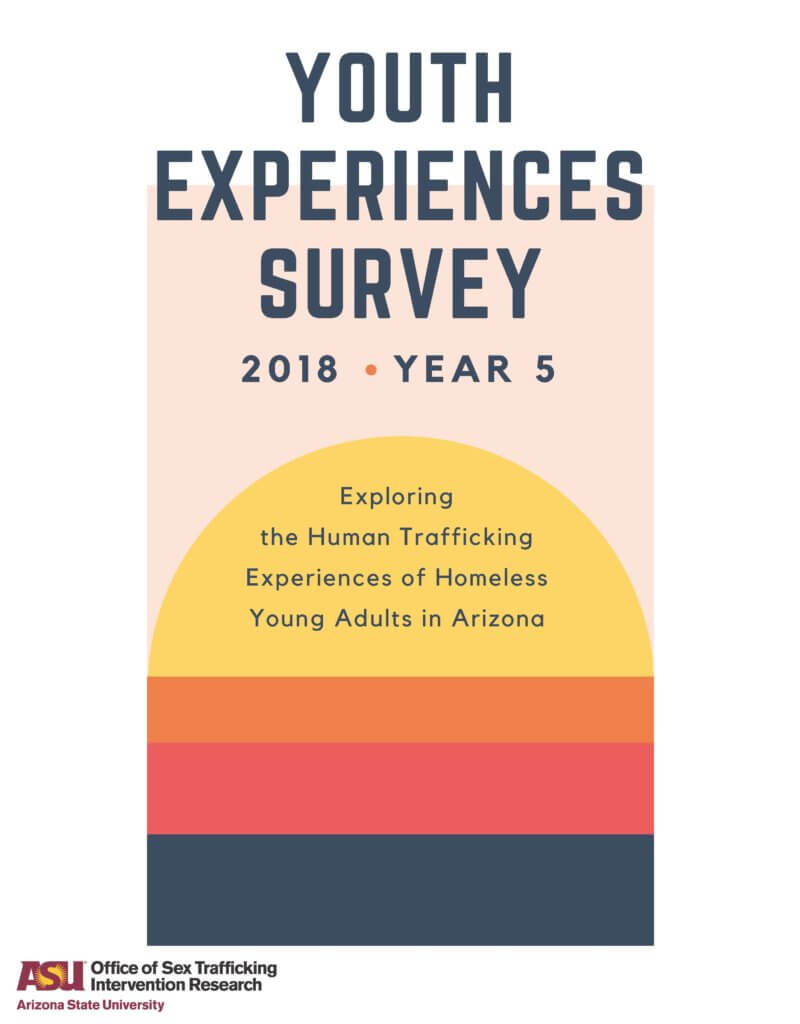
Authors
Dominique Roe-Sepowitz, MSW, Ph.D.
Kristen Bracy, MA, MSW
Kimberly Hogan, MA, MSW
Arizona State University
This study was funded by The McCain Institute for International Leadership at Arizona State
University, Our Family Services, UMOM, and the Arizona State University School of Social
Work, Office of Sex Trafficking Intervention Research.
Thank you to Our Family Services in Tucson, Arizona, Native American Connections and
one•n•ten in Phoenix and the staff at UMOM for their assistance in collecting this research.

EXECUTIVE SUMMARY
2018 YOUTH EXPERIENCES SURVEY: EXPLORING THE SEX TRAFFICKING EXPERIENCES OF HOMELESS YOUNG ADULTS IN ARIZONA, YEAR FIVE.
The Youth Experiences Survey (YES) is a study of the experiences of homeless young adults in Arizona that has been conducted for the past five years, from 2014 to 2018. The YES study focuses on how the life experiences of Arizona’s homeless young adults increases their risk for experiencing human trafficking. The study was conducted in partnership with four agencies from Phoenix and Tucson that provide direct services to homeless persons: Native American Connections, UMOM, one.n.ten of Phoenix, and Our Family Services of Tucson. The findings from the YES study has provided insight about the challenges and needs of Arizona’s homeless young adults to better target needed services as well as the first of its kind knowledge of the scope of the sex and labor exploitation of this population in Arizona.
Identifying sex and labor trafficking among homeless young adults is confounded by access issues which make this population difficult to study- issues such as that they are transient, are difficult to find, and are involved in fewer social service and medical service agencies than other homeless youth due to their status as adults. This study targeted homeless young adults in multiple settings including transitional housing, drop-in centers, and on the streets of Tucson and Phoenix.
A seven-page paper survey was distributed to homeless young adults over two weeks in July 2014, July 2015, August 2016, August 2017, and July 2018 by staff from the above mentioned homeless young adult serving partner agencies. This report includes the findings from all of the participants including details about their homelessness experiences, substance use, mental and medical health history, family challenges, as well as risk and protective factors. The sex trafficking and labor exploitation experiences of the participants are also discussed, and a comparison of the trafficked versus non-trafficked participants is provided. Finally, notable trends over the five-year YES data collection are highlighted. Finally, future research and targeted service provision recommendations are discussed.
BRIEF SUMMARY OF FINDINGS
STATUS OF HOMELESS YOUNG ADULTS IN ARIZONA IN THE 2018 YOUTH EXPERIENCES SURVEY
(N = 179)
Participant Profile
- 179 participants responded to the Youth Experiences Survey in 2018.
- The average age of the 179 homeless young adult participants was 20.8 years old.
- Males represented 50.8% of the participants, followed by females at 41.3%, transgender at 3.9% and other (genderqueer, two-spirit, non-conforming) at 3.4%.
- Participants identified as heterosexual (45.8%) and LGBTQ (39.7%).
- 63.7% of the participants were raised in the state of Arizona, and the others were from 19 other states.
Housing and Homelessness
- The average age of the participants’ first homelessness experience was 16.3 years of age.
- The participants reported experiencing an average of four periods of homelessness during their lifetimes.
- Participants reported currently living in: a transitional housing program (26.3%), on the streets (25.7%), in a shelter (18.4%), couch surfing (16.8%), in their own place paid by themselves (6.7%) or in a hotel (1.7%).
Challenges and Risk Factors
- Drug use was reported by over half of the sample (n = 102, 57%), with the most frequently used drugs reported including marijuana (n = 60, 33.5%) and methamphetamines (n = 47, 26.3%).
- Over half (n = 96, 53.6%) of the participants reported engaging in self-harm behaviors (cutting, risk taking, burning themselves, etc).
- A suicide attempt was reported by one of every three (n = 64, 35.8%) participants.
- A majority (n = 123, 68.7%) of the participants reported a current mental health diagnosis and over half (n = 93, 53.6%) reported having more than one mental health diagnosis.
- The most common mental health diagnoses reported by participants included anxiety (n =89, 49.7%) and depression (n =78, 43.6%).
- Over half (n = 97, 54.2%) of the participants reported experiencing a current medical problem. The most common medical problems reported included poor vision (n = 45, 25.1%) and asthma (n = 44, 24.6%).
- 38% (n = 68) of the participants reported being kicked out of their homes by their families.
- Almost half (n = 85, 47.5%) of participants reported running away from home.
- Almost half (n = 81, 45.3%) of participants reported experiencing emotional childhood abuse.
- About one in every three (n = 54, 30.2%) participants reported experiencing sexual abuse before the age of eighteen.
Adverse Childhood Experiences
- Participants had an average of four ACEs.
- 44.7% (n = 80) of participants had experienced between zero and three ACEs.
- Over half (n = 92, 51.4%) of participants had experienced four or more ACEs.
STATUS OF HOMELESS YOUNG ADULT VICTIMS OF HUMAN TRAFFICKING IN ARIZONA
Of the 179 homeless young adult participants, 62 (34.6%) reported experiencing sex trafficking exploitation and 55 (30.7%) reported experiencing labor exploitation. At least one form of human trafficking (either sex or labor) was reported by 80 (44.7%) participants and 37 (20.7%) participants reported experiencing both sex and labor exploitation.
Sex Trafficking Findings (n = 62)
- 62 (34.6%) of the total sample (N = 179) reported experiencing sex trafficking exploitation.
- 39.2% (n= 29) of the female participants self-reported that they had experienced sex trafficking.
- 31.9% (n = 29) of the male participants self-reported that they had experienced sex trafficking.
- The average age of first sex trafficking experience was 17.1 years old with 29% (n= 18) reporting that they were sex trafficked before the age of 18.
- 87.1% (n = 54) of the participants who reported being sex trafficked reported that they had at some point had a sex trafficker, with 12.9% (n = 8) of the participants reporting the current presence of a sex trafficker.
- The most common reasons identified by the 58 participants that reported sex trafficking victimization were for a place to stay (54.8%), money (46.8%), and for food (27.4%).
COMPARING SEX TRAFFICKED AND NON-SEX TRAFFICKED YOUNG ADULTS
- When comparing the sex trafficked homeless young adult participants with the non-sex trafficked homeless young adult participants using an odds ratio test, the sex trafficked group was found to be:
- Two times more likely to report being LGBTQ.
- Three times more likely to report a drug addiction.
- Four times more likely to report an alcohol addiction.
- Three times more likely to report engaging in self-harming behaviors.
- Six times more likely to be kicked out by their family due to substance use.
- Four times more likely to report experiencing dating violence.
- Four times more likely to report experiencing sexual abuse before the age of 18.
- Eight times more like to report experiencing labor exploitation.
Labor Exploitation Findings (n = 55)
- 55 (30.7%) of the participants (N = 179) reported experiencing labor exploitation.
- One out of every four (n = 19, 25.7%) female participants reported experiencing labor exploitation.
- Over one out of every three (n = 31, 34.1%) male participants reported experiencing labor exploitation.
- The average age of first labor exploitation experience was 17.3 years old with 25.5% (n = 14) reporting that they were exploited for labor before the age of 18.
- 81.8% (n= 45) of the participants who reported being exploited for labor reported that they had at some point had a labor exploiter, with 1.8% (n = 1) of the participants reporting the current presence of a labor exploiter.
- The most common reasons identified by the 55 participants that reported labor exploitation were for money (47.3%), a place to stay (36.4%), and for food (23.6%).
The most common sectors that participants reported experiencing labor exploitation included: drug selling (n = 11, 20%), hotels (n = 10, 18.2%), petty theft (n = 7, 12.7%),and restaurants (n = 5, 9.1%). - When comparing the labor exploited homeless young adult participants with the nonlabor exploited homeless young adult participants using an odds ratio test, the labor exploited group was found to be:
- Three times more likely to report a drug addiction.
- Three times more likely to report an alcohol addiction.
- Three times more likely to report engaging in self-harming behavior.
- Three times more likely to report drinking alcohol excessively as a form of selfharm.
- Six times more likely to report engaging in sex with strangers.
- Five times more likely to report engaging in risk taking behaviors.
- Four times more likely to report body modification as a form of self-harm.
- Three times more likely to report binging/vomiting behavior as a form of selfharm.
- Three times more likely to report a suicide attempt.
- Three times more likely to report a current mental health diagnosis.
- Three times more likely to report having more than one mental health diagnosis.
- Four times more likely to report experiencing chronic pain.
- Four times more likely to report experiencing dating violence.
- Four times more likely to report experiencing sexual abuse before the age of 18.
- Three times more likely to report experiencing physical neglect before the age of 18.
- Three times more likely to report negative contact with law enforcement.
- Three times more likely to report having worked in the adult entertainment industry.
- Three times more likely to report emotional childhood abuse.
- Three times more likely to report harassment by peers.
- Eight times more likely to report experiencing sex trafficking exploitation.
KEY FINDINGS
The average age of first homelessness for the 179 homeless young adult participants was
16 years old creating a particular set of risks for victimization as they are minors with limited
options for employment and many are avoiding contact with child welfare services or any
systems (medical, mental health, law enforcement) thus creating even more risks. Homeless
young adults who have experienced sex and labor exploitation are at increased risk among their
peers to have serious drug and alcohol problems, have experienced abusive childhoods,
particularly sexual abuse histories, been in abusive dating relationships, and were more likely to
have serious mental health challenges including a history of suicide attempts, depression,
anxiety, and Post- Traumatic Stress Disorder. Due to the broad spectrum of challenges faced by
sex trafficked and labor exploited homeless young adults, targeted programming and
interventions are recommended.
BRIEF CONCLUSION
The experiences of homeless young adults in Arizona continue to be complex and multifaceted
with the necessity to address the resulting problems or challenges with innovation,
creativity, and partnerships within each community. Sex trafficked and labor exploited homeless
young adults may appear to have some of the most complex needs among homeless young
adults. Screening for sex trafficking and labor exploitation/trafficking can assist programs in
identifying victims and providing intensive and purposefully designed housing and therapeutic
interventions addressing a wide array of issues that the victims face. The results of the 2018 YES
survey call on Arizona’s community to develop a comprehensive approach to screen for both
labor and sex trafficking among homeless and runaway young people and to develop community
protocols that outline services standards. Additional state and community based funding is
necessary to assist providers in maintaining services that meet the complex needs of our
homeless youth and young adults.
